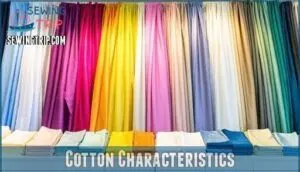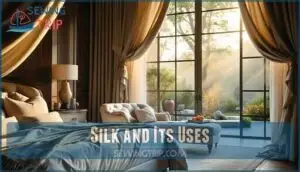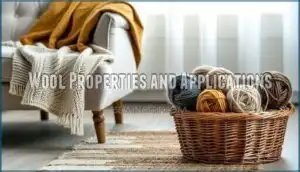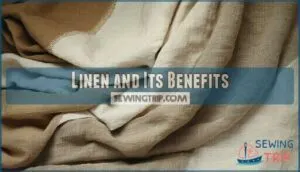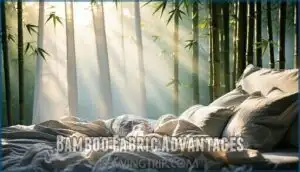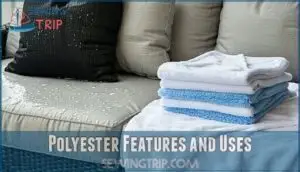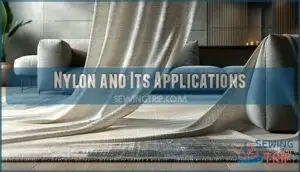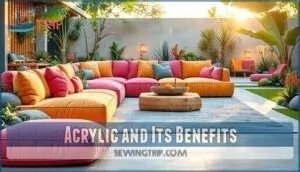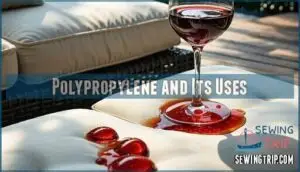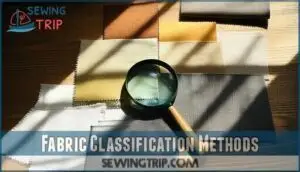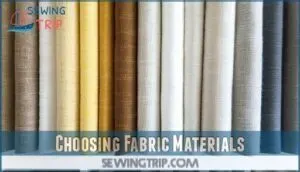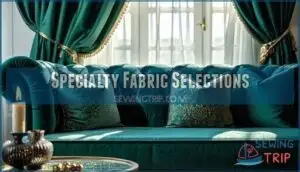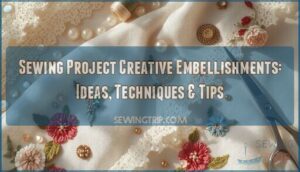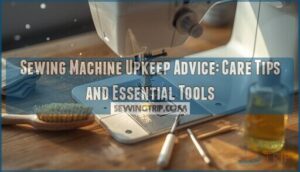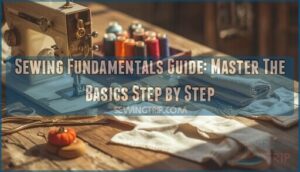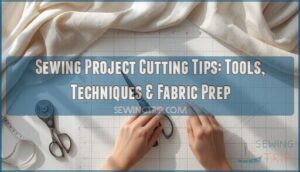This site is supported by our readers. We may earn a commission, at no cost to you, if you purchase through links.
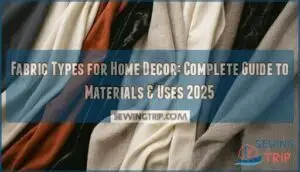
Cotton offers breathability and easy maintenance for curtains and cushions, while linen brings texture and sophistication to window treatments.
Silk adds luxury to formal spaces, though it requires careful handling.
Synthetic polyester provides durability and fade resistance for high-traffic areas, making it practical for upholstery.
Velvet creates rich visual depth in accent pieces, while canvas works perfectly for sturdy furniture covers.
Each fabric’s weave density, fiber content, and finish affect its performance in specific applications.
Understanding these characteristics helps you make informed choices that balance aesthetics with functionality.
Table Of Contents
Key Takeaways
- You’ll get the best performance by matching fabric properties to room function – choose durable polyester blends for high-traffic areas like family rooms, while reserving delicate silk for formal spaces that see less wear.
- Natural fabrics like cotton and linen offer superior breathability and comfort, but synthetic options like polyester provide unmatched stain resistance and fade protection that’s perfect for homes with kids and pets.
- You can identify fabric types through simple tests – feel the texture, check how it drapes, and perform a small burn test to distinguish between natural fibers that char and synthetics that melt into beads.
- Specialty fabrics like velvet and suede create dramatic visual impact, but you’ll need to factor in higher maintenance requirements and costs when deciding if their luxury appeal fits your lifestyle and budget.
Natural Fabric Types
You’ll find that natural fabrics like cotton, linen, silk, and wool offer unique properties that make them ideal for different home decor applications, from breathable cotton curtains to luxurious silk upholstery.
These plant and animal-derived materials provide excellent durability and comfort, though they often require more careful maintenance than their synthetic counterparts, which can be a consideration for breathable cotton curtains and other decorative elements that demand luxurious feel.
Cotton Characteristics
Cotton’s your go-to natural fabric for home decor, offering unmatched breathability and versatility.
Cotton delivers the perfect balance of comfort and practicality that every home decorator craves.
You’ll find various cotton weaves from soft percale to durable twill, each with different thread counts affecting texture and durability.
Cotton fabric types excel at dye absorption, creating vibrant colors that last, and easy care maintenance makes cotton perfect for bedding, though stain protection helps preserve upholstery longevity.
Silk and Its Uses
When you’re ready to elevate your space, silk fabric decor brings unmatched luxury to any room.
Silk production creates varieties like mulberry and tussah, each offering unique textures for draperies and upholstery.
This premium material delivers exceptional silk durability when properly maintained.
However, silk care requires attention—keep it away from direct sunlight to preserve those luxurious finishes that make silk special.
Wool Properties and Applications
Warmth meets versatility when you choose wool for your home decor projects.
This natural fabric’s exceptional wool insulation properties make it perfect for cozy blankets and throws, while its wool durability guarantees your upholstery withstands daily use.
Wool textures range from smooth to chunky, and wool blends combine strength with softness.
Its wool sustainability credentials make it an eco-friendly choice for bedding. Natural fibers also offer superior moisture management compared to synthetics.
Linen and Its Benefits
Linen fabric choices offer unmatched breathability and natural texture for your home decor projects.
This flax-derived material showcases exceptional Linen Durability despite its lightweight feel.
Various Linen Weaves provide different aesthetics, from crisp to relaxed finishes.
While Linen Cost runs higher than cotton, its Linen Sustainability and moisture-wicking properties make it worthwhile.
Among natural fabrics, linen’s Linen Texture adds sophisticated appeal to any space.
Bamboo Fabric Advantages
Choosing bamboo fabric transforms your home into an eco-friendly sanctuary.
This natural fabric delivers unmatched bamboo softness while maintaining superior breathability that outperforms cotton.
You’ll appreciate its resiliency and antibacterial qualities that keep furnishings fresh longer.
Its biodegradability means you’re making responsible choices for future generations while enjoying luxurious comfort today.
However, the bamboo viscose process uses an open-loop system with higher solvent loss compared to modal.
Synthetic Fabric Options
When you’re furnishing your home on a budget or need fabrics that can handle spills from kids and pets, synthetic options offer practical solutions that natural fibers can’t match.
You’ll find these man-made materials provide exceptional durability, stain resistance, and easy maintenance while mimicking the look and feel of premium natural fabrics at a fraction of the cost, offering a fraction of the cost.
Polyester Features and Uses
Polyester dominates synthetic fabrics because it’s your go-to workhorse for busy homes.
This durable upholstery fabric laughs at spills, resists fading, and bounces back from daily abuse.
You’ll find it everywhere from cushions to curtains, often blended with natural fibers for enhanced performance.
Top Polyester Applications:
- Heavy-traffic upholstery – Sofas and chairs that endure constant use
- Outdoor furniture covers – Weather-resistant protection for patio pieces
- Microfiber cleaning cloths – Superior dirt-trapping capabilities for household tasks
Nylon and Its Applications
Nylon stands out among synthetic fabrics for its exceptional strength and elasticity.
You’ll find this powerhouse material in high-traffic carpets, heavy-duty curtains, and durable upholstery blends.
Nylon’s resilience makes it perfect for busy households, though it costs more than basic polyester.
While nylon sustainability raises concerns, its longevity often offsets environmental impact through reduced replacement needs.
Acrylic and Its Benefits
Most synthetic fabrics promise durability, but acrylic delivers exceptional performance for home decor projects.
Most promises fade with time, but acrylic fabric delivers lasting beauty that transforms your home into a masterpiece of comfort and style.
You’ll discover this wool alternative offers remarkable benefits for both indoor and outdoor applications.
- Acrylic Durability withstands heavy use without breaking down like natural fibers
- Weather Resistance makes it perfect for patio furniture and outdoor cushions
- Color Retention prevents fading even after years of sun exposure
- Softness Comparison rivals wool’s comfort at fraction of the cost
- Pilling Resistance maintains smooth texture through countless wash cycles
Polypropylene and Its Uses
When you’re hunting for bulletproof outdoor fabric solutions, polypropylene delivers unmatched stain resistance and durability.
This synthetic fabric laughs at spills, weather, and wear while keeping costs down.
You’ll find it perfect for patio furniture, outdoor cushions, and high-traffic upholstery, plus, recycling options make it eco-friendly.
It’s the workhorse that keeps performing when other materials quit.
As a nonwoven textile, it boasts high moisture-wicking capabilities, making it a great choice for outdoor use with unmatched stain resistance and durability.
Fabric Classification Methods
You’ll need reliable methods to identify fabric types when shopping for home decor, especially since mislabeled materials can lead to costly mistakes in your decorating projects.
Understanding basic classification techniques helps you make informed decisions about durability, care requirements, and suitability for specific applications in your home.
Visual Inspection Techniques
Looking beyond fabric composition, your eyes become powerful tools for fabric identification in home decor projects.
Visual inspection reveals essential details about fabric types through careful observation of specific characteristics.
Here’s what to examine during your fabric assessment:
- Fabric Texture – Notice surface smoothness, raised patterns, or napped finishes
- Weave Patterns – Identify plain, twill, or satin weaving structures
- Color Consistency – Check for even dye distribution and Print Alignment
- Defect Detection – Spot flaws, pulls, or manufacturing inconsistencies
Understanding fabric surface variations aids in proper classification.
Burn Test Procedures
The burning test reveals fabric types through flame characteristics and residue analysis.
Light a small sample with tweezers, observing how it burns, melts, or chars.
Cotton burns quickly with yellow flames, while polyester melts into hard beads.
Note the odor identification—wool smells like burning hair.
Before testing, it’s important to source necessary burn test supplies.
Always follow safety precautions and make certain proper equipment calibration before conducting fiber composition tests.
Touch and Feel Analysis
Five simple touch tests reveal fabric identity instantly.
Run your fingers across the surface to assess Fabric Hand and Texture Perception—cotton feels soft yet sturdy, while silk glides smoothly.
Test Drape Quality by letting fabric fall naturally; linen hangs stiffly, polyester flows gracefully.
Evaluate Softness and Tactile Comfort through gentle rubbing, noting whether fabric textures feel rough, smooth, or somewhere between.
Microscopic Examination Methods
Professional microscopic examination transforms fabric identification from guesswork into precise science.
You’ll discover hidden details that determine quality and performance in your home decor projects.
Essential microscopic analysis techniques:
- Fiber Identification – Reveals true material composition beyond misleading labels
- Weave Analysis – Exposes structural integrity that impacts longevity
- Damage Assessment – Uncovers microscopic flaws before they become problems
- Finish Evaluation – Identifies protective treatments affecting durability
The weave’s structure impacts fabric’s drape, influencing its suitability.
Choosing Fabric Materials
You’ll need to match fabric characteristics with your specific home decor project requirements, considering factors like room function, expected wear patterns, and maintenance preferences.
Smart fabric selection involves evaluating durability ratings, stain resistance levels, and aesthetic qualities to guarantee your chosen material performs well in its intended environment while meeting your style goals.
Identifying Project Requirements
Before selecting fabric types for home decor, you’ll need to map out your project requirements.
Start by defining room function and lifestyle factors that’ll impact fabric suitability.
Consider budget constraints, design style preferences, and existing color palettes.
Whether you’re redecorating a high-traffic family room or creating a serene bedroom retreat, these foundational decisions guide smart fabric selection choices.
Evaluating Fabric Properties
Understanding fabric properties becomes your compass when exploring home decor choices.
You’ll need to assess key characteristics that determine long-term satisfaction with your investment.
Consider these essential evaluation criteria:
- Durability Testing – Check fabric strength through stretch and pull tests
- Fiber Content – Read labels to understand natural versus synthetic composition
- Weave Structure – Examine tight versus loose construction for longevity
- Colorfastness – Test color retention under sunlight exposure
- Texture Analysis – Feel surface smoothness and stain resistance capabilities
For superior performance, consider fabric drape properties to influence flow and silhouette.
Considering Aesthetic Preferences
Your aesthetic preferences shape every fabric choice you’ll make. Consider how different fabric types complement your personal style and existing interior design.
Color palettes should flow naturally through your space, while texture combinations add visual interest without overwhelming the room.
| Design Element | Natural Fabrics | Synthetic Options |
|---|---|---|
| Color Palettes | Earth tones, muted hues | Vibrant, fade-resistant colors |
| Texture Combinations | Organic, varied textures | Smooth, consistent finishes |
| Pattern Matching | Subtle, natural patterns | Bold, geometric designs |
Pattern matching becomes easier when you understand how fabric aesthetics work together to create visual harmony in your home decor.
Assessing Durability and Maintenance
Smart durability choices often determine whether your fabric investment thrives or fails within two years.
Stain resistance and proper cleaning methods make all the difference between premium upholstery fabric durability and costly replacements in high-traffic areas.
Evaluating fabric performance standards is essential for longevity.
- Wear Testing Results – Quality fabrics withstand 30,000+ double rubs
- Fiber Strength Analysis – Synthetic blends outperform pure natural materials
- Stain Resistant Material – Professional treatments extend lifespan 40%
- Long-Term Care Requirements – Factor maintenance costs into fabric care decisions
Specialty Fabric Selections
When you’re ready to elevate your home’s style beyond standard cotton and polyester, specialty fabrics like velvet, chiffon, and suede offer unique textures and visual appeal that transform ordinary spaces into sophisticated retreats.
These premium materials require careful consideration of their specific properties, maintenance needs, and placement locations, but they’ll reward you with distinctive character that guests won’t forget, providing a unique visual appeal with sophisticated retreats.
Velvet and Its Uses
Velvet upholstery options transform ordinary furniture into statement pieces that’ll make your guests do double-takes.
This plush fabric for upholstery offers exceptional velvet durability when you choose quality weaves.
Crushed velvet adds dramatic flair to accent chairs, while traditional velvet textures work beautifully on sofas.
Though velvet cost runs higher, proper velvet cleaning maintains its luxurious appeal for years in your home decor.
Chiffon and Its Applications
Chiffon brings ethereal beauty to your home with its gossamer-thin texture and flowing drape.
This delicate fabric creates stunning visual effects when light filters through its airy weave, making it perfect for layering with heavier materials.
Here are three popular chiffon applications:
- Sheer curtains that softly diffuse sunlight while maintaining privacy
- Bridal decor for romantic wedding ceremonies and receptions
- Light draperies that add movement and elegance to any room
Suede and Its Benefits
Moving beyond delicate chiffon, suede brings tactile luxury to your home decor projects.
This napped fabric offers unmatched softness for cushions and throws, though genuine suede requires careful maintenance. Faux suede provides similar appeal with easier cleaning, making it practical for upholstery applications where durability matters most.
One key difference is that suede uses inner layers of the animal hide.
| Feature | Genuine Suede | Faux Suede | Applications |
|---|---|---|---|
| Durability | Moderate wear resistance | High durability for daily use | Cushions, accent pieces |
| Maintenance | Professional cleaning required | Machine washable options | Throws, pillows |
| Cost | Premium pricing | Budget-friendly alternative | Upholstery, decorative items |
| Texture | Authentic napped feel | Consistent synthetic finish | Statement furniture pieces |
Luxurious Fabric Options for Home Decor
When transforming your space into a sophisticated retreat, luxurious fabrics elevate any room’s aesthetic.
These premium materials combine beauty with functionality, creating environments that feel both elegant and inviting.
- Velvet Durability – Rich texture withstands daily use while maintaining opulent appearance
- Silk Alternatives – High-quality synthetics offer similar sheen at accessible prices
- Faux Fur – Cruelty-free options provide warmth and visual interest
- Patterned Brocade – Intricate designs add sophisticated drama to upholstery
- Sustainable Luxury – Eco-friendly premium fabrics support responsible decorating
Frequently Asked Questions (FAQs)
What are the three types of fabric decoration?
Like an artist’s palette offering endless possibilities, you’ll find three main fabric decoration types: printed designs applied during manufacturing.
Woven patterns created through interlaced threads, and embellished textures added through embroidery or appliqué techniques.
How to choose fabric for interior design?
Consider your room’s function, lighting, and traffic when selecting fabrics.
You’ll want durable polyester or cotton blends for high-use areas, while silk adds luxury to formal spaces.
Match fabric weight to your specific needs.
What are the 5 fabric names?
Cotton dominates 45% of upholstery choices in modern homes. You’ll encounter five essential fabric types: cotton for versatility, linen for breathability, silk for luxury, wool for warmth, and polyester for durability.
What is the most durable fabric for upholstery?
Nylon stands as your toughest upholstery choice, handling heavy traffic like a champ.
Polyester runs a close second with excellent stain resistance.
Both synthetic fabrics outlast natural options, making them perfect for busy households with heavy traffic.
How do fabric blends affect home decor performance?
Fabric blends combine natural and synthetic fibers to enhance durability, reduce wrinkles, and improve stain resistance.
You’ll get cotton’s softness with polyester’s strength, creating upholstery that’s easier to maintain while keeping comfort.
What are best fabric storage and preservation methods?
Your grandmother’s vintage silk curtains lasted decades because she rolled them in acid-free tissue.
Store fabrics in breathable cotton bags, avoid plastic wrapping, maintain consistent temperature, and keep them away from direct sunlight to prevent fading.
Keep them in a manner that prevents damage, following the steps to ensure longevity.
Which fabrics work best for pet-friendly homes?
You’ll want microfiber, solution-dyed acrylic, and tightly woven polyester blends.
These resist stains, repel pet hair, and handle frequent washing.
Avoid velvet, silk, or loose weaves that trap fur and show scratches easily.
How does room humidity impact fabric choices?
Ever wonder why some fabrics feel sticky in summer?
High humidity makes natural fibers like cotton and linen absorb moisture, causing wrinkles and mildew.
You’ll want synthetic blends or treated fabrics for humid rooms.
What are current home decor fabric trends?
You’re seeing bold geometric patterns, earthy tones, and sustainable materials dominate 2025’s home decor scene.
Mixed textures like bouclé with linen create visual interest, while vintage-inspired fabrics add character to modern spaces.
Conclusion
Like a master craftsman selecting the perfect tool for each task, you’ve now discovered how choosing the right fabric types for home decor transforms your living space.
Whether you’re drawn to cotton’s practicality, silk’s elegance, or polyester’s durability, each material serves its purpose.
Remember that successful decorating isn’t about following trends—it’s about understanding your needs, testing fabric properties, and making informed decisions.
Your home deserves fabrics that’ll look beautiful while standing up to daily life’s demands.
- https://thefabricofourlives.com/cotton-fabrics
- https://www.britannica.com/topic/silk
- https://www.washingtonpost.com/lifestyle/home/outdoor-fabrics-suitable-for-indoor-use/2014/05/27/36d734e4-e068-11e3-810f-764fe508b82d_story.html
- https://sewport.com/fabrics-directory/polypropylene-fabric
- https://www.sciencedirect.com/topics/materials-science/polypropylene

